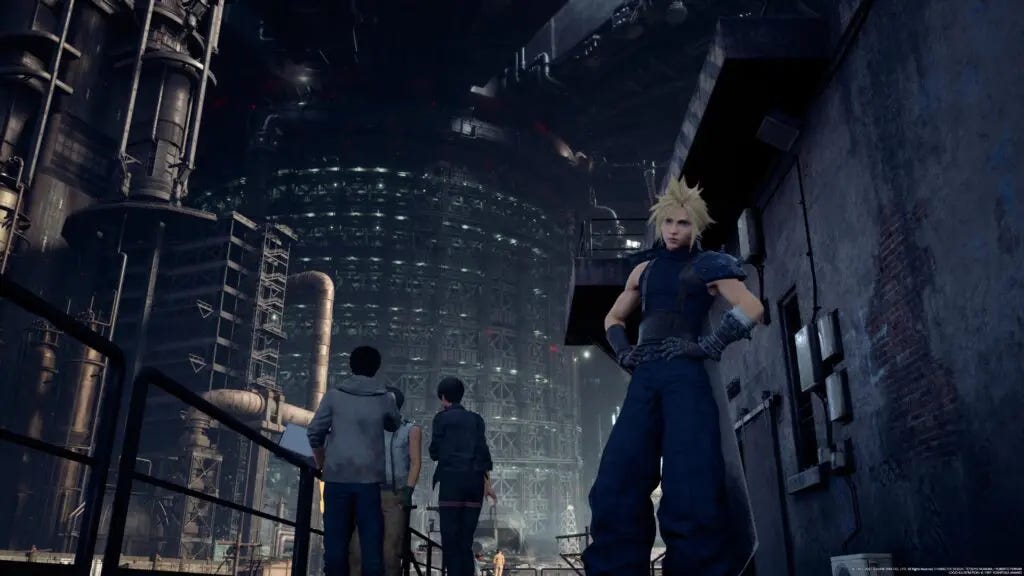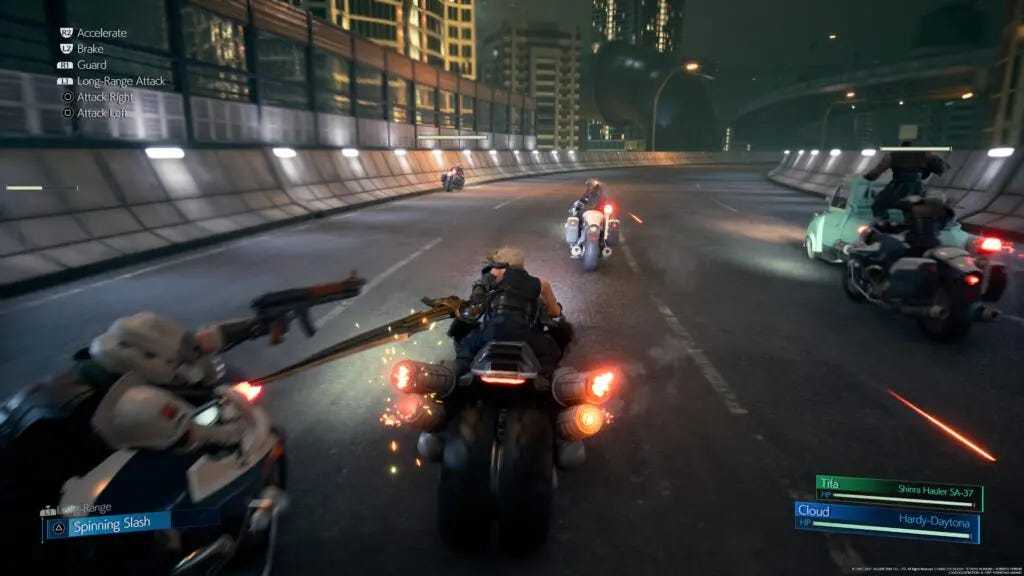Final Fantasy VII Remake Intergrade – Review (PS5)
Final Fantasy VII Remake Intergrade is a brilliant game, and whilst it has a few pacing issues, it's still a fantastic, premium experience.
Final Fantasy VII was originally released on the PlayStation in 1997, and has gone on to become one of the all time greatest and most beloved JRPGs ever made. Fans have been clamouring for a remake or a remaster for years, and this was finally realised in 2020 on the PlayStation 4, with the PlayStation 5 edition coming out in June 2021, in the form of Final Fantasy VII Remake Intergrade.
Firstly, let’s cover what’s different between the PS5 and PS4 versions, so that anyone reading this review that has played the PS4 one, knows whether or not they’d like to upgrade. The major differences are in performance and graphics. The PS5 version features better framerates, higher resolution graphics, additional volumetric fog effects, upgraded textures and some more subtle refinements. Additionally, it features light use of the PS5 haptic feedback in the motorcycle sections. Finally, it adds an additional two story chapters to the game, featuring Yuffie, which we will come onto later. If you’re looking for a proper technical breakdown, then check out Digital Foundry’s video here.
If you’ve never played the original, here is a brief outline of the games narrative (without spoilers of course!). You play as Cloud Strife, a mercenary that used to work for the big baddies of the game, the Shinra Electric Company. Cloud takes up mercenary work helping a group of eco-warriors ‘Avalanche’, to take down some of Shinra’s Mako reactors. Mako energy is used to power the technologically advanced city of Midgar and provide its citizens with luxuries, but Avalanche believes this energy comes from the Earth’s lifestream, and using Mako will eventually kill the Earth.
The above paragraph is essentially the main setup of the game, playing as a mercenary to take down a big evil corporation. There are three more playable characters in addition to Cloud, Barret Wallace and Tifa Lockheart, whom are members of Avalanche, and Aerith Gainsborough, a local florist met later in the game by chance. The game is split into 18 chapters, and which character you play as changes all the time, with the party members chopping and changing, with only three ever in battle together at once. It is a very narrative heavy game, and the story keeps pushing forward, not lingering in any one place for too long. This is clearly a marked difference to the original, but I think it makes sense for the story they are trying to tell.
In addition to the main cast, there are plenty of supporting characters that get a chance to shine. Fellow Avalanche members Jessie, Biggs and Wedge all get big story beats, as well as many others. The game does have a tendency to introduce characters perhaps a little late, with Rufus Shinra and Hojo being such examples. They both become big villains towards the end of the game, but we only hear about them sparingly prior to that. This is probably the biggest issue with the game, and that is the pacing isn’t optimum. There are portions of the game which are essentially just about moving from one big story moment to the next one, and don’t feature much more than arbitrary puzzles to get through it. That being said, these parts do not make up the bulk of playtime, but they do stop the game from reaching those top marks.
In addition to the more scripted linear paths, the game features a few areas that are more open. These are the Sector 5, Sector 7 and Wall Market slums. Each of these areas features a number of side-quests that you can complete, ostensibly to earn your marks as a mercenary. Completing these quests grants some nice bits of new equipment, as well as some nice little story elements. They affect the game world too, as bystanders will start remarking on you as a mercenary once you have gained some good reputation. There is also some mini-games in these areas, such as a pull-up bar game, darts, coliseum, battle simulator, and some other things. There’s always new stuff to try in each area, and I like the way it’s been set out. The side-quests themselves are often quite varied, and are much better than the ones in Final Fantasy XV for example, which were usually just fetch quests.
In terms of the core gameplay, Square Enix has doubled down on ‘action rpg’. Those people that were hoping for a replication of the originals battle mechanics will have to look elsewhere. The battle system consists of open arenas, in which battles are played out in real time. Pressing square will execute standard attacks, whilst pressing triangle will execute some kind of strong attack or technique. When a gauge on the ATB is filled up, you can execute an ability or a spell, making use of materia.
Materia is just as important in this remake as it was in the original, granting everything from spells to summons to buffs, mixing and matching is one of the core mechanics. Each weapon or piece of equipment will come with a set number of materia slots, but this can be upgraded over time. Weapons in particular have plenty of upgrade options open to them, providing several playstyle routes, such as magic or attack focused. It does offer a good level of customisability, but there is one snag to this. Since each chapter mixes up who will be in the party, you can’t really rely on having one character be the ‘healing’ character and one being a ‘tank’ for example, since they may not always be around. That means its important to be flexible, and upgrade characters in a way that allows them to be more flexible.
Personally, I enjoy the battle system. It may not be quite as engaging as the originals turn-based system, but I still find it a lot of fun, and it definitely matches the cinematic tone of the game. During some of the more scripted battles with lots of cinematics and other things going on around, it really does make everything feel intense. Exploiting enemy weaknesses and building up a great team synergy to take down bosses quickly can still feel immensely satisfying. Additionally, the game does feature what it calls a ‘classic’ mode, but I would caution against this. It basically just puts everything into auto play, with the player just controlling which spells and abilities to use, it’s not worth it.
In terms of graphics, this game is stunning. Square Enix has a lot of credentials in this space, and produces some of the best looking games anywhere, so it’s obvious that one of their most prized properties would receive the premium treatment. The steel city of Midgar shines in a way that somehow looks better than most CGI movies, with the attention to detail being incredible. Looking off into the distance, you can spot so many tiny details in the city, it’s clear the effort that was put into this production. Each of the characters too looks great, and there is just no fault I can find with the games presentation. Really, this is a title you just have to see to believe. The music too, is great. Thankfully, Square Enix has not seen to change the music, with most of the score being reimagined versions of the original music. All the same cues are there, and hearing Tifa’s or Aerith’s theme again just brings those memories straight back.
In terms of the PS5 upgrade, it features an additional two chapters, starring Yuffie. These two chapters take place mostly in areas from the original game, and the story is more of a side-story than anything which affects the main narrative. Yuffie fights differently to Cloud too, having her own set of materia based moves, allowing her to switch between and close and ranged attacks at a whim. These two chapters are quite a nice addition, but make sure to play them after you’ve played the main story, as the game doesn’t try to re-explain its core mechanics.
I can’t wait for the next entry in this remake. I know a lot of people were disappointed that this game only covered the Midgar section of the original, but by the end of the game you can see that was clearly a choice rather than a limitation, and I think it means the next game could end up being something quite different. Final Fantasy VII Remake Intergrade is a really brilliant game, and whilst it has a few pacing issues, it’s such a fantastic, premium rush of an experience that I would recommend it to any gamer.
Rating: 4 out of 5.
You can check out Square Enix official site for the game here or purchase through Amazon here.









